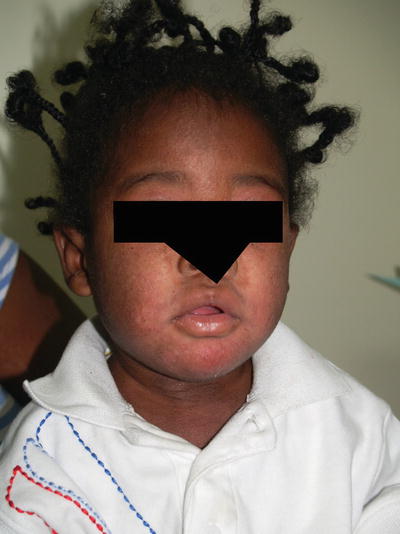Fig. 30.1
Post-inflammatory hyperpigmentation seen in child with facial atopic dermatitis
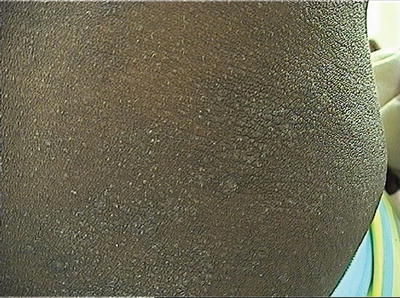
Fig. 30.2
Patchy pigmentation evident in an area of active dermatitis with no visible erythema
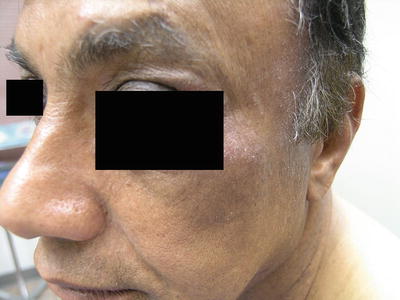
Fig. 30.3
Eyelid dermatitis with hyperpigmentation and lichenification
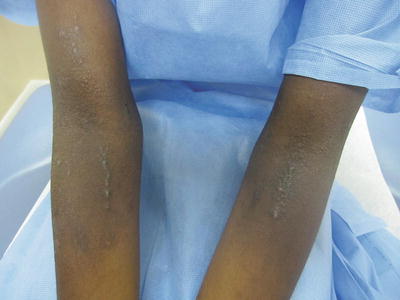
Fig. 30.4
Linear lichenification and hyperpigmentation from past flares that may lead to over-estimation of disease activity
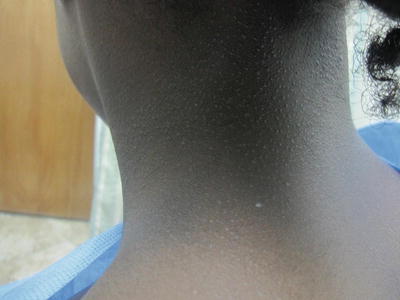
Fig. 30.5
Papular atopic dermatitis in an African-American child
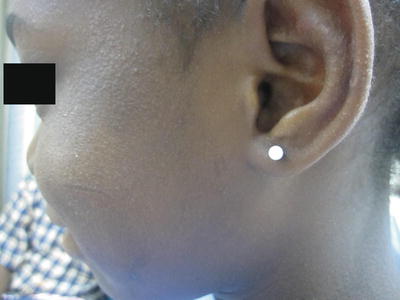
Fig. 30.6
Fine hyperpigmented papules on the face in an area of active contact dermatitis
Diagnosis/Treatment
Allergic contact dermatitis should be suspected when there is recalcitrant or escalating dermatitis despite adequate therapy.
The gold standard diagnostic tool is patch testing.
Pre- and post-patch testing counseling is critical to successful management of ACD through allergen avoidance.
Once the suspicion of contact dermatitis has been raised, appropriate workup begins with a history and physical examination to determine whether the contact dermatitis is allergic or irritant in nature. About 80 % of all contact dermatitis is due to an irritant. Clues to this diagnosis are immediate onset of dermatitis within 36 h of the eliciting exposure. Depending on the concentration of the irritant, there may be erythema, scale, edema, and with exposure to extremely strong irritants, vesiculation. The dermatitis is due to direct injury of epidermal cells and subsequent release of inflammatory mediators. Patients should be educated about the importance of adequate barrier repair and avoidance of irritants.
Two other types of contact dermatitis ACD and protein contact dermatitis, PCD, account for the lion’s share of the remaining 20 % of contact dermatitis. Contact urticaria, a type-I IgE mediated hypersensitivity reaction, accounts for a minority of cases. A delayed type hypersensitivity to an allergen, ACD, should be suspected when the history and physical exam suggest a pattern of dermatitis with an external causation, and when there is recalcitrant or escalating dermatitis despite adequate therapy.
In the last two decades it has become increasingly recognized that children are affected by ACD. In fact, 80 years ago, it was recognized that infants were susceptible to contact sensitization [16]. Positive patch test reactions indicative of sensitization are found across all age groups, including children under 3 years of age [17]. In the past it was thought that rates of sensitization increased with age, because numbers of exposures increased with time. More recently, however, reports have documented that younger children, particularly those under 10, have more contact sensitization [18]. Furthermore, studies from the Europe performed between 1998 and 2005 demonstrate a peak age for sensitization being in those patients 3 years and younger [19–21]. It is important to note that the prevalence of ACD in pediatric patients in the USA is especially difficult to ascertain, since large population-based studies are difficult to do in children and most affected children are not subjected to confirmatory patch testing. A meta-analysis of articles about pediatric ACD published by Simonsen et al. in 2011 showed pediatric sensitization rates of 26.6–95.6 % and relevance rates of 51.7–100 % [18].
Once a patient is suspected to have an ACD, the gold standard diagnostic tool is patch testing (Fig. 30.7). There have been several published series suggesting a standard patch test allergen series for pediatric patients. The size of the patient can limit the number of patches that can be applied and studies report testing from as few as 10 to more than 185 allergens [22–26]. Of note, there is no FDA indicated patch test device available for testing children. The T.R.U.E™ test (SmartPractice, Phoenix, Arizona) is a pre-packaged, commercially available series of 35 allergens (plus 1 negative control) approved for use in adults in the USA. This has been successfully used on children in an off-label fashion, with or without supplemental allergens and in clinical trials [27–29].
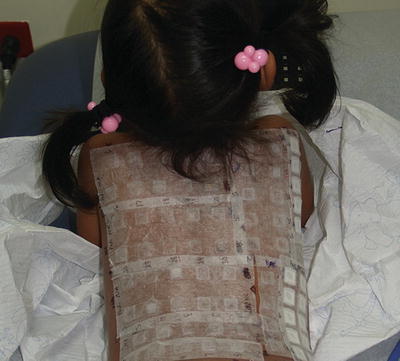

Fig. 30.7
Child undergoing patch test application to expanded series
Allergen series such as the American Contact Dermatitis Society [ACDS] core series, the European Standard series, and the North American Contact Dermatitis Group (NACDG) standard screening series have been developed for more comprehensive patch testing and have been used successfully in children. Use of an expanded series increases true positive detection rates when compared to the limited series available commercially. The NACDG demonstrated that 39 % of children would have had their positive relevant patch tests missed with the FDA-indicated commercially available patch test device available at the time of the study [25, 26].
Many centers that have published their data on pediatric patch testing apply standard technique to patch testing children, though some report a modified technique in pediatric patients [30–32]. Some centers decrease the concentration of some allergens (e.g. nickel, formaldehyde, fragrance mix, potassium dichromate, rubber accelerators, and cobalt) when testing infants and very young children [30]. Very intense reactions have been noted in children under 16 with para-phenylenediamine which suggests that this should be tested in a lower concentration or a decreased exposure time of 24 h as is done in Germany [33]. Many referral centers routinely update their allergen standard series to reflect changing patterns of exposure and allergens that have been found to be highly irrelevant. For example, thimerosal continued to boast high detection rates that were clinically not relevant, as the reactions associated with past exposure during childhood to vaccinations. Further, adding to the complexity of evaluating reported results is the fact that timing of patch readings is not standardized across referral centers. Pediatric patients (as is seen in adults) may have delayed positive patch test results (noted at a 7–9 day visit) to relevant allergens not identified at the earlier visits [34].
The use of supplemental allergens when testing children is just as important as when testing adults. Certain patterns of dermatitis, such as foot or flank, may call for testing with a supplemental series, such as shoe or textile. Patients with a preexisting history of atopic dermatitis may have sensitization to topical corticosteroids and some groups advocate testing children with a standard series and supplemental allergens that include corticosteroid allergy screening agents [23]. Careful history may elicit exposures to potential allergens that would be missed with only a standard series. Environmental exposures that are traditionally thought to be occupational in nature should still be considered in children based on detailed inquiry into hobbies, family businesses, and schooling. Zug et al. found that both the NACDG standard series and the two-panel T.R.U.E.™ test would have missed the supplemental allergens detected in 15.9 % of children [25].
Allergens
Children are experiencing ACD in a similar fashion to adults. And, at both ends of the age spectrum and with impairment of barrier (filaggrin mutations, ceramide reduction) an increase in ACD can be seen, which unfortunately might mimic atopic eczema or xerosis [18]. A study of NACDG data from 2000 to 2004 showed that children had similar rates and allergens of relevance (about 50 % of those tested) to adults [25]. The most common relevant allergens in the 391 children tested over a 4-year period were nickel sulfate (26.0 %), cobalt (12.4 %), neomycin (4.4 %), fragrance mix (4.1 %), gold (3.6 %), and quaternium 15 (3.6 %). Children also had higher rates of thimerosal sensitization though this was often deemed clinically irrelevant to their current dermatitis, and more associated with its use as an antiseptic and preservative in vaccines [28]. Furthermore, an analysis of six studies done at four North American patch test groups revealed a number of similarities in common with positive patch tests including nickel as the most commonly detected allergen, Myroxylon pereirae and other fragrances being heavily represented, neomycin, formaldehyde, and formaldehyde-releasing preservatives were also commonly detected [35].
Nickel is the most frequent allergen in children and adolescents across a vast majority of studies. Children are commonly sensitized to metals. The top three allergens identified in a series of 136 children patch tested at Mayo Clinic over a 7-year period were nickel, cobalt, and gold [24]. Note, cobalt is a commonly identified allergen that often coexists with nickel and may be considered to be a marker of nickel or metal sensitivity as it is infrequently positive in isolation.
Data on sensitization rates in various ethnic groups can be obtained from population-based studies on ACD. There are many limitations to this approach including very low numbers for smaller minority groups in the USA and lack of ability to generalize to populations outside of the study area. It is possible that an assessment of whether a child’s exposure patterns seem most like the community in which they live versus the community of ethnic origin may be useful in guiding allergen selection.
A review of patch test data from 12 NACDG centers over a 6-year period compared rates of sensitization among black and white patients in the USA [36]. The patients tested reflected the ethnic distribution of the overall population, were predominantly female in both groups, and had hand, generalized, and facial dermatitis. The allergens detected were similar in both groups across the study period with minor variations, which may not reflect true differences. Black adult patients were more likely to have para-phenylenediamine sensitization during 4 of the 6 years possibly reflecting higher concentration of para-phenylenediamine in darker hair dye. White patients showed more sensitization to formaldehyde releasing preservatives, possibly reflecting a preference to creams, which require more biocides, over ointments, in contrast to preferences seen in black individuals.
Reviewing the international literature (non-US) regarding pediatric ACD, Maitz et al. [37] found that the most common allergens across the world are nickel, cobalt, fragrance, antibiotics, and rubbers. Interpretation of patch test data is influenced by choice of tested allergens, which may differ between countries. For example, Croatia has high rates of white mercury precipitate contact sensitization in pediatric patients (6.2 %), while this allergen is rarely tested in other parts of the world [38]. A meta-analysis done by Bonitsis et al. [39] in 2011 of 49 studies done on at least 100 children worldwide found that the top ten allergens, among those tested in at least two studies, were nickel sulfate, ammonium persulfate, gold sodium thiosulfate, thimerosal, toluene-2,5 diamine, palladium chloride, cobalt chloride, metallic mercury, mercuric chloride, and p-Aminophenol.
Racial and ethnic groups that have been reported to be affected by allergic contact dermatitis:
Caucasian, Asian, Black, Hispanic, Israeli, Indian, Turkish, Japanese, Brazilian, Singaporean, Spanish, German, Norwegian, Portuguese, English, Italian, Polish, Austrian, Finnish, Greek, French, Dutch, Swiss, Canadian, Croatian, and American [37].
Education
Pre- and post-patch testing counseling is critical to successful management of ACD through allergen avoidance. Previous experience with prick testing may lead to significant confusion on the part of the family and needle phobia from the children and delay the initiation of patch testing. Once testing has been completed, pediatric patients often have many barriers to allergen avoidance. Lengthy counseling sessions can be difficult for parents, when concomitantly caring for an uncomfortable child. The complexity of environmental control is confounded by exposures at school or during extracurricular sports [32].
Confounding Factors
What seems to be most clear when examining differences in sensitization rates across ethnic groups is that allergen exposure patterns are influenced by cultural and regional practices, not “Fitzpatrick skin type” or skin color. Skin color should not be used as a proxy for an understanding of exposure patterns in different ethnic groups. However, knowledge of the types of potentially allergenic products used by children of color can be invaluable when planning to patch test. Some cultural practices to be considered are age at first piercing and number of piercings, use of ceremonial paints and dyes, and hair styling practices.
Children of color may also have comorbidities that could increase their potential for sensitization. Black children in the USA are more likely to have atopic eczema/dermatitis (AD) than white children [13]. Black children with AD are also six times more likely than white children to have severe disease [14]. The role of AD as a predisposing factor for ACD is controversial, as they do appear as independent phenomena and at the same time may coexist in individuals. Furthermore, clinical features of AD and ACD overlap to an extent that compromises the results of clinical studies [40].
There are an increasing number of proponents suggesting that moderate to severe AD should be an indication for patch testing due to a high rate of sensitization seen in children with high AD severity scores [28] (Figs. 30.7 and 30.8). At least 50 % of children with AD may have a positive patch test (PPT) and evidence of sensitization [22, 23, 28]. Children with AD may also have differences in PPT results from non-atopic children. In a study on 101 children using the three-panel T.R.U.E. test, the AD children had higher rates of sensitization to Balsam of Peru (20 %) and fragrance mix (19 %) [29]. Reported positive patch test results to cocamidopropyl betaine (CAPB) have been questioned as being irritant instead. That said, CAPB has been reported to be a relevant allergen in patients with atopic dermatitis [41]. Overall, the most commonly detected allergens are similar in AD and non-AD children (Fig. 30.9).
